New Study Shows Local Economic Benefits of Wind Farms
 | Isak Kvam, Communications / Policy Associate |
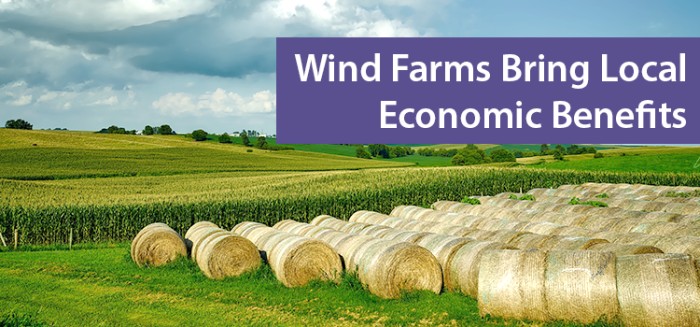
 | Isak Kvam, Communications / Policy Associate |
It’s easy to list the reasons that rural communities love wind — they provide a new source of tax revenue for counties and townships, lease payments for rural landowners, new jobs and economic development in areas that need it most, and they help to fund community projects and schools.
Now, a new report from Moody’s Investors Service highlights how wind projects are boosting tax revenues and helping erase debt in rural communities that host them.
Wind Projects Improve Rural County Finances
A utility-scale wind farm is a multi-million dollar project that provides a significant new source of tax revenue for the counties and townships through the Wind Energy Production Tax. Since 99 percent of wind projects are built in rural America, wind farms provide relief for small, rural towns that need it most.
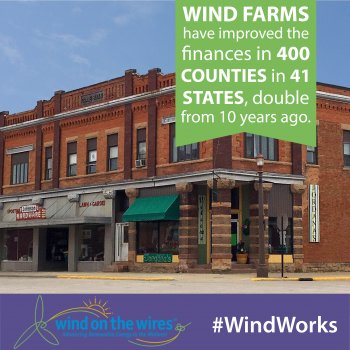 According to Moody’s, wind
farms have improved the finances in more than 400 counties in 41 states, which
is more than double the counties that had wind farms 10 years ago. This new
source of revenue provides funding for local
infrastructure projects like improving roads and bridges, community projects and schools, or
holding the line (or even cutting) property taxes paid by citizens.
According to Moody’s, wind
farms have improved the finances in more than 400 counties in 41 states, which
is more than double the counties that had wind farms 10 years ago. This new
source of revenue provides funding for local
infrastructure projects like improving roads and bridges, community projects and schools, or
holding the line (or even cutting) property taxes paid by citizens.
Let’s dive into two rural counties in the Midwest that have benefitted from wind farms — Adair County, Iowa and Jackson County, Minnesota.
Wind Farms Have Increased Adair County, Iowa’s Tax Base by 30 Percent
Not far from the famous covered bridges of Madison County lies Adair County, Iowa. Adair is a rural county near Des Moines with a population of 7,054. Only a decade ago, the county was facing hard economic times. The declining tax base meant there wasn’t enough money for the county to maintain its roads and bridges. That spelled trouble for local farmers who relied on local infrastructure to handle large machinery and truckloads of grain. Today, thanks to the influx of revenue from wind development, roads have been improved and a new bridge makes travel safe for everyone.
Subscribe to our newsletter for the latest on energy & our work
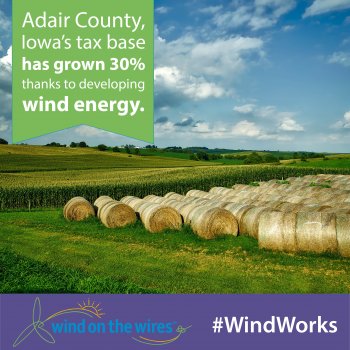 Adair County now has over 400 MW of wind from two wind projects
developed by MidAmerican Energy, the local electric utility with a 100
percent renewable energy goal. MidAmerican Energy will pay $3.5 million in property taxes this year, with $2 million going
to the county. In all, MidAmericannergy’s wind projects provide 25 percent of Adair County’s budget.
Adair County now has over 400 MW of wind from two wind projects
developed by MidAmerican Energy, the local electric utility with a 100
percent renewable energy goal. MidAmerican Energy will pay $3.5 million in property taxes this year, with $2 million going
to the county. In all, MidAmericannergy’s wind projects provide 25 percent of Adair County’s budget.
Statewide, MidAmerican Energy is investing $3.6 billion to install wind turbines in Iowa by 2019, the largest economic development project in Iowa’s history. This will generate approximately $12.5 million per year in property tax payments statewide, $18 million per year in landowner payments, and $48 million per year in state and local expenditures associated with the project.
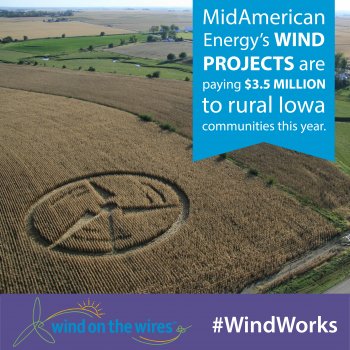 Before the wind projects were developed, roads and bridges
in Adair County were in very poor condition. Now that the wind farms have come
online, officials have completed most of the infrastructure projects that were
so sorely needed, and they’re even considering property tax cuts! The benefits
from wind are continuing to grow — MidAmerican just
announced it will add an additional 550 MW of wind capacity in Adair
County.
Before the wind projects were developed, roads and bridges
in Adair County were in very poor condition. Now that the wind farms have come
online, officials have completed most of the infrastructure projects that were
so sorely needed, and they’re even considering property tax cuts! The benefits
from wind are continuing to grow — MidAmerican just
announced it will add an additional 550 MW of wind capacity in Adair
County.
Wind Energy Delivers 20 Percent of County Tax Revenue in Jackson County, Minnesota
Rural communities across the Midwest are benefitting from wind — and Jackson County is no outlier. The county is expected to get more than 20 percent of its annual operating revenue from wind energy’s production tax. Residents across Jackson County are benefitting from wind energy whether they have a turbine on their property or not. The county recently completed a new, $14 million public works facility that, thanks to wind energy, local residents weren’t even asked to chip in to pay for. Additionally, wind farm revenue has prevented a 14.5 percent increase in property taxes for residents.
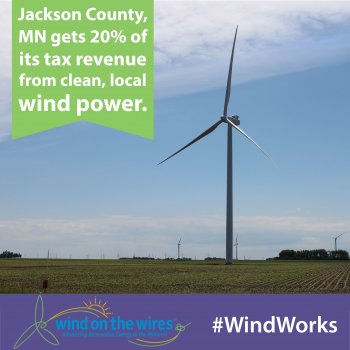 Jackson County has
received an average of $1.6 million per year in tax revenue from wind
energy since 2012. They host about 600 MW of wind energy and continue to use
the tax revenue to relieve tax burdens for local residents and support capital
improvements. The Odell Wind Farm developed by Geronimo Energy and now owned
and operated by Algonquin Power & Utilities started a community
fund to finance charitable community projects and opportunities. In fact,
it recently awarded $39,000 for Chromebooks at schools and
funding for a local library, fire departments, ambulance services, 4-H, FFA,
robotics, and more! But that’s not all that wind farms provide.
Jackson County has
received an average of $1.6 million per year in tax revenue from wind
energy since 2012. They host about 600 MW of wind energy and continue to use
the tax revenue to relieve tax burdens for local residents and support capital
improvements. The Odell Wind Farm developed by Geronimo Energy and now owned
and operated by Algonquin Power & Utilities started a community
fund to finance charitable community projects and opportunities. In fact,
it recently awarded $39,000 for Chromebooks at schools and
funding for a local library, fire departments, ambulance services, 4-H, FFA,
robotics, and more! But that’s not all that wind farms provide.
Wind projects also provide new, family-supporting jobs for folks that want to live in small, rural towns. The Lakefield Wind project employs 12 people with well-paying jobs (Minnesota Wind Energy Technicians’ Median Wage is $26/hour). “I am so fortunate to be able to live close to family and come back to my rural community,” said Josh Zeitz, site manager of the Lakefield Wind Project.
Wind is also providing a new source of revenue for local landowners. “Wind energy is helping me pass our fourth-generation farm to our son. I’ve been nothing but happy with my turbines and the whole process,” said David Hanson, a landowner that hosts 3 Lakefield Wind turbines on his property.
Wind energy is investing in rural communities across the Midwest by providing new tax revenue, new jobs, new lease payments for farmers, and new hope for communities that need it most.
Portions of this blog post were also published in MinnPost.
Want to learn more about renewable energy? Sign up for our monthly "Renewable Champions" newsletter to get the latest stories and resources about the Midwest's transition to renewable energy.